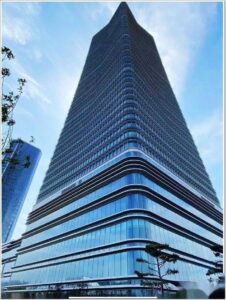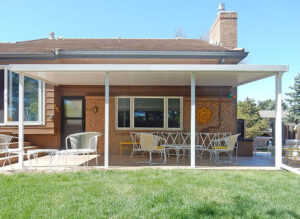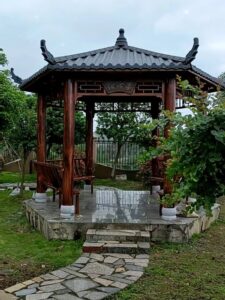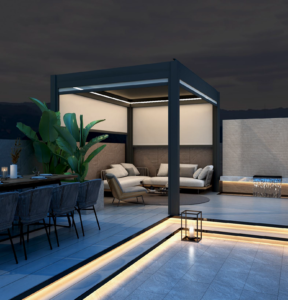
What is the best type of wall covering?
What is the best type of wall covering? Tired of staring at dull walls but overwhelmed by options? The “best” wall covering depends entirely on
A curtain wall is a type of architectural structure that forms the outer covering of a building but is not a part of its structural integrity. Essentially, it is a non-load-bearing system that hangs or “curtains” from the building’s framework. It is designed to protect the interior of the building from environmental factors such as wind, rain, and temperature variations while offering aesthetic and functional benefits. The curtain wall is typically made from lightweight materials like glass, aluminum, or steel to minimize the load on the building’s foundation.
Despite its lack of structural purpose, the curtain wall plays a critical role in the overall performance of the building. It provides thermal insulation, controls light infiltration, enhances energy efficiency, and even contributes to the acoustics of a building. The development of curtain walls has significantly evolved with modern architectural trends and technologies, allowing for sleek designs and towering glass skyscrapers.
This blog post explores curtain walls in depth: their types, benefits, materials, installation processes, and considerations when selecting a curtain wall manufacturer for your project.

The concept of curtain walls dates back to medieval times when exterior walls were constructed separately from the actual load-bearing structures of castles and fortresses. However, modern curtain walls came into prominence during the 19th century with advancements in building materials such as steel and glass.
One of the earliest curtain walls was constructed in 1918 for the Hallidie Building in San Francisco. Since then, curtain wall systems have been widely adopted in commercial buildings, particularly high-rise skyscrapers, due to their ability to create expansive glass facades.
Curtain walls are generally categorized into two main types based on their construction method and installation process: stick systems and unitized systems.
In stick systems, the components of the curtain wall, such as mullions (vertical elements) and transoms (horizontal elements), are installed piece by piece on-site. The glass or panel infill is installed afterward, making this method highly labor-intensive. Stick systems offer flexibility in design and are usually more economical for smaller projects or buildings with more complex architectural designs. However, the installation process can be time-consuming and weather-dependent since it requires significant on-site labor.
Advantages of Stick Systems:
Disadvantages of Stick Systems:
Unitized curtain wall systems, on the other hand, are pre-fabricated in a factory and arrive on-site as complete units. These units typically consist of large sections of curtain walls, including the glass or panel infill, which are pre-assembled. The installation process is quicker and less reliant on on-site labor, making unitized systems ideal for larger projects, such as high-rise buildings.
Advantages of Unitized Systems:
Disadvantages of Unitized Systems:
To fully understand the structure of a curtain wall, it’s essential to explore its main components. Each component plays a critical role in ensuring the curtain wall functions effectively and meets performance standards:
Mullions are the vertical elements that support the weight of the curtain wall system. They are attached to the building’s frame and serve as the primary structural support for the infill materials such as glass or panels.
Transoms are the horizontal elements that intersect with the mullions. They help distribute the load across the system and provide additional structural support for the infill materials.
The infill is the material placed between the mullions and transoms. The most common infill material is glass, but metal panels, stone, or even terracotta can also be used, depending on the design and requirements of the building.
Gaskets and sealants are used to create weatherproofing between the curtain wall’s joints. They prevent water, air, and sound from penetrating the building while allowing for thermal expansion and contraction of the materials.
Anchors are crucial for attaching the curtain wall to the building’s main structure. They ensure that the entire system is secure and able to withstand external forces such as wind loads.
Curtain walls can be made from various materials, each offering distinct advantages depending on the building’s design and environmental conditions. Common materials include:
Glass is the most popular material used in curtain walls, providing a sleek, modern appearance that allows for natural light to enter the building. Various types of glass can be used, including tempered, laminated, or insulated glass units (IGUs). IGUs are particularly useful in enhancing a building’s energy efficiency by reducing heat transfer.
Aluminum is often used for the frames of curtain walls due to its lightweight, corrosion-resistant, and durable nature. It can be easily shaped and molded into various profiles, making it an excellent choice for modern architectural designs. Additionally, aluminum is highly recyclable, making it a sustainable option.
Steel provides greater strength than aluminum and is often used in projects requiring more robust structural support. Steel curtain walls are ideal for buildings in high-wind zones or seismic regions, where additional strength is necessary.
In some cases, curtain walls may feature stone, terracotta, or composite panels as infill materials instead of glass. These materials offer a more traditional or natural appearance and can provide better insulation or acoustical benefits, depending on the design.
Curtain walls offer a range of benefits, making them a popular choice for both commercial and residential buildings. Some of the key advantages include:
Curtain walls provide a sleek, modern appearance that enhances the overall aesthetic of a building. With glass as the primary infill material, they offer unobstructed views and allow for natural light to flood the interior spaces, creating a sense of openness.
Curtain walls play a significant role in improving a building’s energy efficiency. High-performance glass and insulation materials can minimize heat transfer, reducing the building’s heating and cooling needs. Modern curtain walls can also incorporate features such as solar shading or photovoltaic cells to harness solar energy.
One of the primary functions of a curtain wall is to protect the building from environmental elements. Curtain walls act as a barrier against wind, rain, and extreme temperatures, improving the overall durability of the structure.
In busy urban environments, curtain walls can provide excellent acoustic insulation, reducing noise pollution from the outside. Laminated glass or other acoustic-enhanced infill materials can be used to achieve this effect.
Many curtain wall systems are designed to be fire-resistant, preventing the spread of fire between floors. This is particularly important in high-rise buildings where fire safety is a critical concern.
Curtain walls are non-load-bearing and typically made from lightweight materials like aluminum and glass. This reduces the overall weight of the building, allowing for taller structures without putting additional strain on the foundation.
When embarking on a construction project that involves curtain walls, selecting the right curtain wall manufacturer is crucial. The quality of materials, expertise, and support from the manufacturer can significantly impact the success of the project. Here are some factors to consider:
Look for manufacturers with a proven track record of delivering high-quality curtain wall systems for projects similar to yours. Experienced manufacturers understand the complexities of curtain wall design, fabrication, and installation, ensuring that your project meets performance standards.
Every project has unique requirements. A good curtain wall manufacturer should offer customizable solutions to meet your specific design, material, and performance needs. Whether you need custom shapes, colors, or specialized glass, the manufacturer should be able to accommodate your requests.
The quality of the materials used in a curtain wall system directly affects its performance and longevity. Choose manufacturers that use high-grade materials such as tempered glass, insulated glass units, and corrosion-resistant metals like aluminum or steel.
A reliable curtain wall manufacturer should provide technical support throughout the project, from design to installation. This includes assistance with calculations, load-bearing analyses, and ensuring compliance with local building codes and regulations.
Sustainability is becoming increasingly important in construction. Look for manufacturers who prioritize eco-friendly practices and materials. This may include using recyclable materials, energy-efficient glazing, and designs that support renewable energy integration.
It’s essential to choose a manufacturer who can deliver within your project timeline and budget. Discuss delivery schedules, lead times, and costs upfront to avoid delays or budget overruns.

Curtain walls have revolutionized modern architecture by enabling the construction of sleek, energy-efficient buildings with expansive glass facades. From skyscrapers to office buildings, these non-load-bearing structures provide aesthetic and functional benefits that enhance both the exterior appearance and interior performance of a building.
Whether you choose a stick system or unitized system, the success of your curtain wall installation largely depends on the quality of materials and expertise of your chosen curtain wall manufacturer.

What is the best type of wall covering? Tired of staring at dull walls but overwhelmed by options? The “best” wall covering depends entirely on

How to import better doors and windows from China? Want high-quality building products at 30-50% below local prices? Importing from China can save you thousands

Is it cheaper to build a pergola or buy one? Struggling to decide between DIY construction and pre-built pergolas? Building your own typically costs 40-60%

What is the difference between curtain wall and cladding? Installing an exterior building envelope and confused about these two systems? Curtain walls are structural glazing

How can I build a pergola? Want to add shade and style to your backyard without professional help? Building a basic 10’x10′ pergola takes 1-2

Worried your beautiful aluminum pergola might sound like a drum solo during storms? Modern aluminum pergolas produce minimal rain noise – typically 40-50 decibels (about